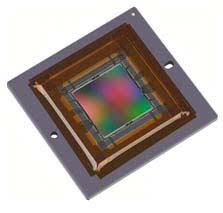ON Semiconductor has launched the newest model of its successful Interline Transfer EMCCD KAE sensor line, for high-quality imaging in extreme low-light conditions. The KAE-08152 is a 4/3” imager with 8.1 Megapixel resolution that provides increased Quantum Efficiency, specifically for NIR wavelengths. The exceptional low-light imaging performance of this sensor is a perfect fit for surveillance, ITS, scientific, and medical applications. All ON Semiconductor image sensors are available from the global imaging expert, FRAMOS®.
Sub-lux imaging is enabled by interline Transfer EMCCD technology. Each of the sensor’s four outputs incorporates both a conventional horizontal CCD register and a high-gain EMCCD register, resulting in exceptional low-light imaging performance. The KAE-08152’s quantum efficiency (QE) is doubled at approximately 850 nm compared to the standard KAE-08151 to provide enhanced NIR sensitivity without any decrease in the device’s Modulation Transfer Function (MTF). An intra-scene switchable gain feature samples each charge packet on a pixel-by-pixel basis, enabling the camera system to route charge through the normal gain output or the EMCCD output depending on a user selectable threshold.
Sibel Yorulmaz-Cokugur, Sensor Expert at FRAMOS, says: “ON Semi’s new KAE-08152 sensor enables imaging in extreme low light, even when bright objects are within a dark scene, allowing a single camera to capture quality images in widely varying conditions, from sunlight to starlight. Another image quality factor is the very low sub-electron noise for EMCCD. All features lead to excellent image uniformity, required in applications where high-sensitive image recognition makes the difference.”
Potential applications that require extreme low-light imaging include wide fields of view for surveillance include border control, aerial monitoring and autonomous vehicles. Other examples like Intelligent Transportation Systems can take advantage of day/night cameras, electronic toll collection, and the precise observation enabled by this special type of image sensor. Astronomy and all types of microscopy applications can benefit from the exceptional image quality and low light performance of the KAE-08152 sensor. Additionally, the extremely high contrast and low readout noise can benefit both diagnostic and surgical procedures in the fields of fluoroscopy, ophthalmology, and dermatology.
The industry and product experts at FRAMOS apply their extensive knowledge of sensors and systems to support customers integrating new sensors into their applications and projects. This knowledge is provided together with the additional services of development support, customizations, and logistics.



















